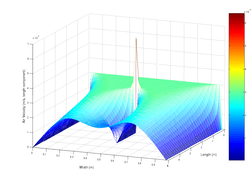tóng-àn:Navier Stokes Laminar.svg

此 SVG 檔案的 PNG 預覽的大小:750 × 600 siōng-sò͘。 Kî-thaⁿ--ê kái-sek-tō͘: 300 × 240 siōng-sò͘ | 600 × 480 siōng-sò͘ | 960 × 768 siōng-sò͘ | 1,280 × 1,024 siōng-sò͘ | 2,560 × 2,048 siōng-sò͘ | 900 × 720 siōng-sò͘.
Choân kái-sek-tō͘ (SVG ùng-giông, chék-cháung: 900 × 720 chuông-só, ùng-giông duâi-nâung:9.37 MB)
Tóng-àn le̍k-sú
Chhi̍h ji̍t-kî/sî-kan, khoàⁿ hit sî-chūn--ê tóng-àn.
| Ji̍t-kî/Sî-kan | Sáuk-liŏk-dù | Chióh-cháung | Iōng-chiá | Chù-kái | |
|---|---|---|---|---|---|
| hiān-chāi | 2016-nî 3-goe̍h 15-ji̍t (pài-jī) 01:06 |  | 900 × 720(9.37 MB) | Nicoguaro | Smaller version |
| 2016-nî 3-goe̍h 15-ji̍t (pài-jī) 00:58 |  | 900 × 720(11.08 MB) | Nicoguaro | Change the jet colormap, since it is recognized as a bad option, in general. Formatting, and pythonic code (and vectorized operations). | |
| 2014-nî 11-goe̍h 6-ji̍t (pài-sì) 23:34 |  | 720 × 540(14.23 MB) | IkamusumeFan | User created page with UploadWizard |
Iáⁿ-siōng liân-kiat
Í-hā ê ia̍h liân kàu chit ê iáⁿ-siōng:
tóng-àn hō͘ lâng sái--ê chōng-hóng
Ē-kha--ê kî-thaⁿ wiki ēng tio̍h chit--ê tóng-àn:
- ar.wikipedia.org hō͘ lâng ēng--ê chêng-hêng
- ary.wikipedia.org hō͘ lâng ēng--ê chêng-hêng
- bcl.wikipedia.org hō͘ lâng ēng--ê chêng-hêng
- ca.wikipedia.org hō͘ lâng ēng--ê chêng-hêng
- Equació diferencial
- Anàlisi d'elements finits
- Plantilla:Equacions Diferencials
- Retrat de fase
- Mètode del volum finit
- Equació característica (càlcul)
- Equació diferencial homogènia
- Estabilitat de Liapunov
- Exponent de Liapunov
- Estabilitat exponencial
- Estabilitat estructural
- Teoria de les pertorbacions
- Teoria de la pertorbació (mecànica quàntica)
- Estabilitat marginal
- Recurrència lineal amb coeficients constants
- Principi màxim
- Principi de màxim de Hopf
- Mètodes numèrics per a equacions diferencials ordinàries
- cy.wikipedia.org hō͘ lâng ēng--ê chêng-hêng
- en.wikipedia.org hō͘ lâng ēng--ê chêng-hêng
- eu.wikipedia.org hō͘ lâng ēng--ê chêng-hêng
- hi.wikipedia.org hō͘ lâng ēng--ê chêng-hêng
- hy.wikipedia.org hō͘ lâng ēng--ê chêng-hêng
- id.wikipedia.org hō͘ lâng ēng--ê chêng-hêng
- ja.wikipedia.org hō͘ lâng ēng--ê chêng-hêng
檢視此檔案的更多全域使用狀況。




